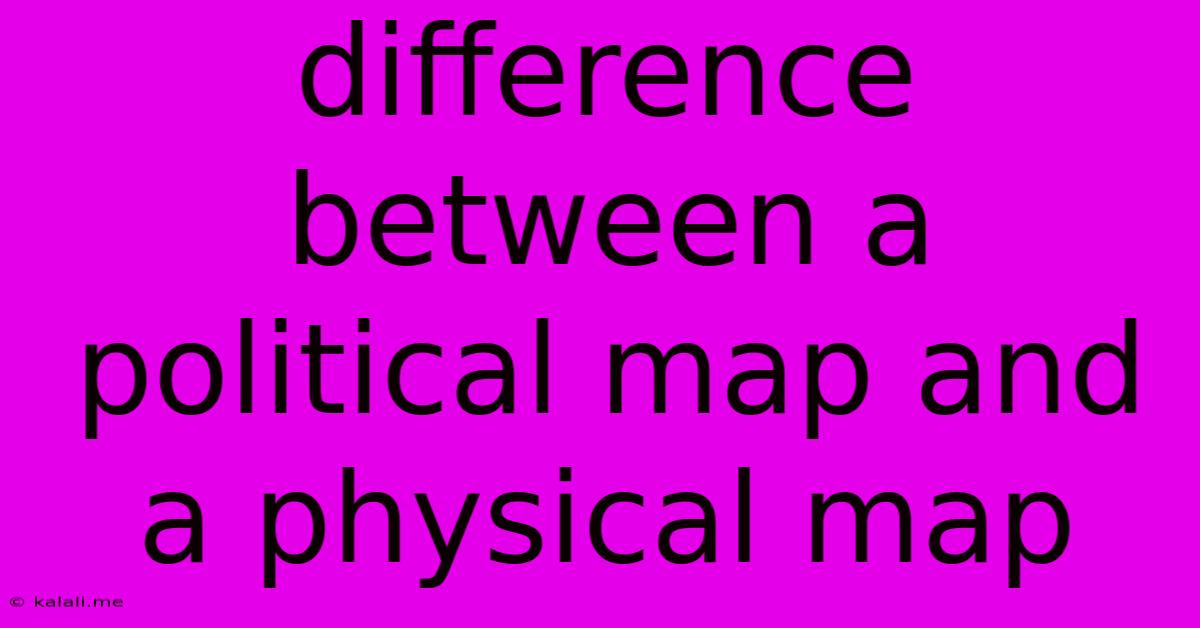Difference Between A Political Map And A Physical Map
Kalali
Jun 15, 2025 · 2 min read

Table of Contents
Delving into the Differences: Political vs. Physical Maps
Understanding the difference between political and physical maps is crucial for anyone navigating geographical information. While both display locations on Earth, they do so with vastly different focuses and representations. This article will explore the key distinctions between these two essential cartographic tools, helping you decipher the information presented on each.
What is a Physical Map?
A physical map primarily showcases the Earth's natural features. Think mountains, rivers, valleys, deserts, plains, and oceans. These features are depicted using various colors, shading, and symbols to indicate elevation, relief, and other geographical characteristics. The goal is to provide a visual representation of the planet's topography and landforms. Key elements often included are:
- Elevation: Shown through contour lines, shading, or color gradients representing different altitudes. Higher elevations are typically shown in lighter colors.
- Relief: Represents the three-dimensional shape of the land, highlighting variations in height and slope.
- Water bodies: Oceans, seas, lakes, rivers, and other bodies of water are clearly marked and often colored blue.
- Vegetation: Some physical maps might include details on vegetation types, like forests or grasslands.
What is a Political Map?
In contrast, a political map focuses on human-created boundaries and divisions. These maps highlight the geopolitical organization of the world, showing countries, states, provinces, cities, and other administrative regions. Their primary purpose is to show the boundaries and relationships between these political entities. Essential elements include:
- Country boundaries: Clearly defined lines separating nations.
- State/province boundaries: Internal divisions within countries.
- Cities and towns: Marked with dots or symbols, often sized proportionally to population.
- Capital cities: Usually highlighted with a star or other special marker.
- Bodies of water: While present, water bodies are secondary to the political divisions.
Key Differences Summarized:
| Feature | Physical Map | Political Map |
|---|---|---|
| Focus | Earth's natural features | Human-made boundaries and divisions |
| Primary Data | Landforms, elevation, water bodies | Countries, states, cities |
| Color Scheme | Often uses color gradients for elevation | Typically uses distinct colors for countries |
| Symbols | Contour lines, shading, symbols for features | Lines for boundaries, symbols for cities |
| Purpose | Show the Earth's physical geography | Show political organization and divisions |
Combining the Power of Both:
While distinct, physical and political maps are not mutually exclusive. Many maps blend both types of information, providing a comprehensive view of a region’s geography and political landscape. These combined maps offer a rich understanding of how human settlements and political structures interact with the natural environment. Understanding the strengths of each map type enables you to interpret geographical information more effectively, whether you're planning a trip, studying history, or analyzing geopolitical situations. Learning to read and interpret both enhances your geographical literacy significantly.
Latest Posts
Latest Posts
-
What Element Is Found In Proteins
Jun 15, 2025
-
What Is 1 Watt Equivalent To
Jun 15, 2025
-
Compare And Contrast Prejudice And Discrimination
Jun 15, 2025
-
College Of The Desert Acceptance Rate
Jun 15, 2025
-
Atoms Combine In Simple Whole Number Ratios To Form Compounds
Jun 15, 2025
Related Post
Thank you for visiting our website which covers about Difference Between A Political Map And A Physical Map . We hope the information provided has been useful to you. Feel free to contact us if you have any questions or need further assistance. See you next time and don't miss to bookmark.